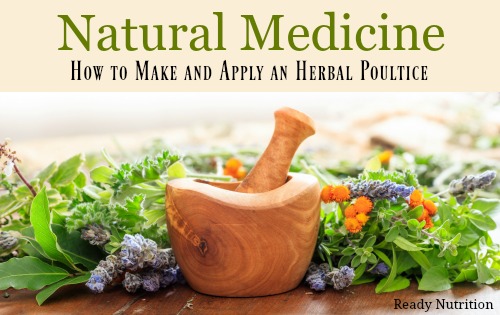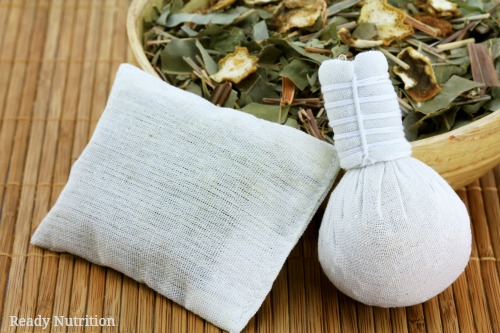
“The fruit of it shall be for eating and leaf of it for healing…” (Ezekiel 47:12)
5 years ago, I came down with a bad upper respiratory infection. I was taking over the counter medicines, but none seemed to work and I was worried about secondary infections. My wife grandmother suggested I make a mustard plaster (poultice) for my chest. She told me that was what her mother did when she was a child. If it would help me with my chest congestion, I’d try anything. You know what? After a few applications, it worked!
We live in an amazing world where everything is provided for, all that is needed is to learn and understand how to use it. In our pursuit to live a more simplistic lifestyle, it is paramount to understand the vast world of herbs. Some of our favorite herbs can be lifesaving and easily grown in our backyard.
One of the easiest and fastest ways to use herbal medicine is by making a poultice. Poultices are one of the safest ways to use herbal remedies directly on the skin. The overall benefit of using this herbal remedy is the direct contact the body will receive from the herb or plant. While poultices are not as concentrated as essential oils or tinctures but they are an effective way of treating insect bites, burns, sore muscles, and sprains. They also assist is in drawing out infections and are great to help with blood poisoning, swollen glands, cysts, boils, pimples, internal injuries and even tumors. As well, poultices can be used to loosen chest congestion, aiding in expectoration of phlegm.
(Sign up for our FREE newsletter to get the latest health advice, gardening secrets, homesteading tips and more delivered straight to your inbox!)
What is Needed to Make an Herbal Poultice

- Assortment of fresh or dried herbs
- Clay
- Muslin, gauze, squares of flannel, disposable tea bags, unused nylon stocking or muslin herbal bag
- Pestle and mortar
- Water
How To Make a Poultice
Familiarize yourself with natural herbs that grow nearby so that you can later forage for these when needed. For instance, plantain is a common green weed that is often found in lawns. If you know how to recognize it, you can use its extensive medicinal qualities. If you are foraging for herbs, make sure the area hasn’t been sprayed with any type of chemical. The most basic poultice applies the herbs to the skin, either directly or folded into a piece of cotton fabric.
In that same vein, this website states that herbal teas and extracts can also be used. “Compresses can be made using teas or extracts. A cloth dipped in arnica can be applied to unbroken skin to relieve bruising and sprains. Hot castor oils packs are unparalleled for rheumatic joints or congested muscles. Cool sage tea soothes abrasions and vinegar compresses are healing for sprains, sore throat, swollen glands, and aching muscles. Lastly, witch hazel is known to reduce the inflammation in varicose veins and hemorrhoids.”
Some popular herbs to have on hand are:
- Aloe vera
- Chamomile
- Calendula
- Comfrey
- Echinacea
- Elderberry
- Golden Seal
- Lavender
- Marsh mallow
- Mullein
- Nettle
- Oats
- Plantain
- St. Johns Wort
- Thyme
- Yarrow
Applying a Poultice
*If you are using fresh herbs or vegetables, mash or grate them and mix with boiling water to form a paste. If you plan on using dried herbs or clay, just add enough boiling water to form a thick paste.
Using both hot and cold poultices will create different reactions from the skin:
Applying a hot herbal poultice relax spasms and relieve pain. They also draw blood to the skin’s surface and increase circulation. The heat also pull impurities to the surface and relieves congestion (like my grandmother’s mustard plaster) to affected areas. To prolong the heat of the poultice, cover with a towel to keep. You can also apply a hot water bottle or heating pad over the poultice. Replace the poultice as it cools down and repeat as needed (for up to an hour at a time). As well, herbs can be added into a large muslin bag and added to the bath.
Applying a cold poultice or compress reduces inflammation and swelling and soothes excess heat that occurs from sunburns, bruises, strains, sprains, swollen glands and mastitis.
Fomentation is an external application of alternating hot and cold poultices to help capillaries dilate and constrict. This manipulation of the blood flow is one of the best and safest mechanisms for removing congestion and obstruction out the system. Apply a cold (kept cold using ice cubes) compress and leave on for 2-3 minutes. Next, apply a hot compress for 2-3 minutes. Alternate between hot and cold for at least 20 minutes. Alternating hot and cold compresses are also particularly useful for sprains to speed healing and repair. Herbs such as elder leaf, ginger, comfrey or horsetail could be of use here.
Note: A good rule with compresses and poultices is that if it feels uncomfortable then remove it immediately. Anything that is too hot or causing irritation or itching is best removed and allowed to cool or discarded. You can also make compresses with a few drops of essential oil dispersed in warm or cold water in place of teas or tinctures.
Best Types of Herbal Poultices
- Wound Healing Poultice – This combination of herbs help to reduce inflammation, sooth irritation, disinfect wounds, stop bleeding and heal tissue. Adding a tablespoon each of dried plantain leaf, Calendula flowers, thyme leaf and yarrow and adding to an empty tea bag will help soothe and heal. This poultice can be made ahead of time and even used on hiking or camping trips. Simply, place the herbs into the tea bag and seal the bag by stapling the ends together. Add tea bags to a plastic container and store in a cool dark place or in first aid kit. To use as a poultice place the bag in hot or warm water and soak for 1- 2 minutes and then apply to the affected area. You can then wrap the area with either a bandage or clear plastic to keep it moist and in place. Healing Antiseptic Wash: The same herbs mentioned above can be used to make a strong antiseptic wash as well. Place the bag in boiling water and steep for 20 – 30 minutes. Allow the liquid to sit until it is cool enough to apply to the skin. Remove the bag and reserve the liquid. Once the liquid is cool enough to apply to the skin it can be used to wash and disinfect the affected area.
- Grandma’s Mustard Plaster – Break up congestion in the sinuses or chest. Use 4 tablespoons of flour, 1 tablespoon dry mustard, lukewarm water and a hand towel to make this poultice. Make a paste with ingredients and add to one half of a hand towel. Fold in half and apply to chest area for 20 minutes. Thoroughly wash off after you are finished applying. Repeat steps to back of chest for 20 minutes and wash off when finished. Take note: mustard can burn the skin. Before using, cover the skin with olive oil and then make sure to remove and check frequently and move the compress around to prevent burning.
- Poultice for Muscle Strains or Broken Bones – Comfrey reduces swelling and heal wounds and is an excellent herb to use in speeding the healing process of sprains, strains and broken bones. St. John’s wort relieves nerve and muscle pain. To make poultice: crush a handful of comfrey leaves and pour enough boiling water in small bowl to cover leaves. Using a mortar and pestle, mash into a pulp and allow to cool off. Once cool, with a spoon spread the pulp directly on the affected area. Cover with gauze and bandage to hold poultice in place. Leave on for several hours.
- Poultice for Insect Bites – Powdered clay including red, green or white clay is an essential component of a natural first aid kit and can help draw out toxins to the surface of the skin from spider bites, mosquito bites, or bee stings. It also relieves swelling from bites. Simply fill a 2-4 ounce container of dry clay, and then moisten with small amounts of water until a paste like consistency is achieved. The paste can be applied to bites, stings, boils, or acne. This poultice can also be used to remove stubborn splinters. Chickweed and lemon balm are also good herbs to use as a poultice for insect bites.
- Poultice for Boils – Onions possess antiseptic properties that act as an antimicrobial and irritant to draw blood and “heat” to the boil. Cut a thick slice of onion and place it over the boil. Wrap the area with a cloth. Change the poultice every three to four hours until the boil comes to a head and drains. You can also use a slippery elm and thyme poultice to draw out boils and heal the skin. Here’s what to do: Mash a handful of thyme leaves and cover with boiling water and allow to cool. Pour off excess water and mix in 2 tablespoons of slippery elm powder. Apply directly to the boil or enclose the pulp in gauze. Leave in place for several hours.
The old ways of doing things should not be disregarded. There is a reason our ancestors used these herbs and why the herbal ingredients continue to be shared. In a time when we are becoming resistant to modern medicines due to overuse, it would be advantageous to start turning back to these old remedies.
We’d love to hear what your favorite poultices are! Share them with the Ready Nutrition Community below.
This article was originally published at Ready Nutrition™ on January 18th, 2017






